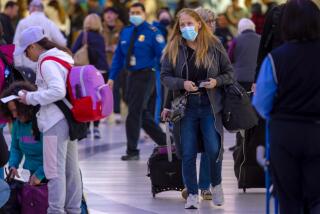Swine flu still spreading, though at a reduced rate
The odds of a third wave of pandemic H1N1 influenza hitting this spring seem to be declining, but authorities are concerned that the virus is still spreading, though at a reduced rate from its peak, and is not disappearing as would be expected in a normal influenza outbreak, federal officials said Friday.
“I think the most likely scenario now . . . is ongoing transmission of the virus, which continues to circulate,” said Dr. Anne Schuchat, director of the Centers for Disease Control and Prevention’s National Center for Immunization and Respiratory Diseases. “It is impossible for me to say whether we will have a very large peak in disease, but we also don’t seem to be seeing a disappearance of this disease.”
“My sense is that we are not at all out of the woods because the virus continues to circulate,” she said in a teleconference. “The chances of a larger wave are difficult to predict, but they may be less likely than continuing circulation of the virus.”
Her thoughts seem to mirror those of the American public. A new poll from the Harvard School of Public Health shows that only 18% of Americans think it is “very likely” that there will be a third wave of swine flu.
Still, with continued circulation, “vaccination remains a good idea,” Schuchat said.
For the third week in a row, flu activity has remained below normal levels for this time of year, with no states reporting widespread activity. Also for the third week, visits to physicians’ offices for influenza-like illnesses have remained low. Such illnesses accounted for 1.9% of all visits to doctors’ offices in the week ending Jan. 30, well below the 2.3% level that authorities consider indicative of an epidemic.
The statistic of most concern is the number of deaths from pneumonia and influenza, which has remained above normal for the third consecutive week, particularly among the elderly. This may mean that the virus is beginning to make its way into the elderly population, which is most susceptible to adverse effects, but which seemed to have some degree of immunity to the virus.
Testing so far, however, has not been able to show whether the deaths are attributable to swine flu or to other viruses that also circulate at this time of year.
Nine more pediatric deaths associated with flu were reported this week, bringing the total of laboratory-confirmed deaths of children to 321. Some of those deaths occurred earlier in the season, however. Officials believe that more than 1,000 children have died of influenza since the pandemic began in April.
About 155 million doses of vaccine are now available, 124 million doses have been shipped, and an estimated 70 million people -- about 23.4% of Americans -- have been vaccinated, Schuchat said. Because some people have received two doses, a total of 76 million doses have been administered.
About 37% of children younger than 18 have gotten at least one dose of vaccine, Schuchat said. The Harvard survey showed that 21% of adults have received it.
Among children who have received a shot, however, only 37% have received the second dose, leaving most still not totally protected.
thomas.maugh@ latimes.com






